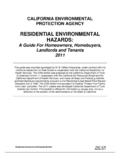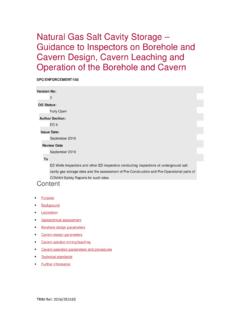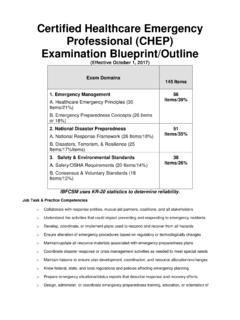Transcription of RR194 - Human factors assessment model validation study
1 HSE Health & safety Executive Human factors assessment model validation study Prepared by Nickleby HFE Ltd for the Health and safety Executive 2004 RESEARCH REPORT 194 HSE Health & safety Executive Human factors assessment model validation study Dr Ron McLeod Nickleby HFE Ltd Sterling House 20 Renfield Street Glasgow G2 5AH This document contains the final report of work performed for the Health and safety Executive, Offshore safety Division (HSE OSD) under contract number D3989. The purpose of the work was to validate a provisional Human factors Capability Maturity model for the oil and gas Industry (HFCMM). The provisional model was prepared in an earlier feasibility study , reported in reference 1. The current document builds on the work presented in reference 1. Specifically, the study set out; 6 to validate the various elements of the provisional model 6 to evaluate the practicality and potential usefulness of the model by applying it to exemplar organisations or projects from across the offshore industry 6 to assess what changes would be needed to make the model applicable to other safety -critical industries, in particular the railway industry 6 to produce supporting material and guidance to assist in using the model .
2 This report and the work it describes were funded by the Health and safety Executive (HSE). Its contents, including any opinions and/or conclusions expressed, are those of the authors alone and do not necessarily reflect HSE policy. HSE BOOKS Crown copyright 2004 First published 2004 ISBN 0 7176 2809 4 All rights reserved. No part of this publication may be reproduced, stored in a retrieval system, or transmitted in any form or by any means (electronic, mechanical, photocopying, recording or otherwise) without the prior written permission of the copyright owner. Applications for reproduction should be made in writing to: Licensing Division, Her Majesty's Stationery Office, St Clements House, 2-16 Colegate, Norwich NR3 1BQ or by e-mail to ii Table of Contents 1. INTRODUCTION .. 1 Structure of the 2 3 2. RATIONALE AND OBJECTIVES .. 5 Background .. 5 Scope: interpretation of ' Human factors '.. 6 The socio-technical systems view.
3 6 The behaviour-centred view .. 6 Interpretation for the 7 7 3. THE Human factors assessment model .. 9 What is 'good practice' .. 9 What is reasonably practical ? .. 10 The model .. 11 Levels .. 11 12 Weightings .. 13 Conducting an assessment .. 14 4. THE GAP WITH CURRENT 21 Scope .. 21 Results .. 22 General overview of the companies .. 22 Observations .. 25 Summary and 28 5. CASE STUDIES .. 31 Sources .. 31 Incident 1: Non-standard materials .. 32 Incident 2: Crane wire rope failure .. 33 Incident 3: Breach of electrical 34 Incident 4: Hand-held remote control 35 Incident 5: Use of wrong plug 36 Incident 6: Operator distracted by 37 Incident 7: Drill hole operations .. 38 Incident 8: Error in operating control 39 Incident 9: Residual hazards following operations .. 40 Incident 10: Electrical pump isolation .. 41 Incident 13: Exhaust fan 42 Incident 14: Thread tape fitted the wrong way round.
4 43 Incident 15: Unsecured electrical isolation .. 44 Incident 16: Positioning of valves .. 45 Affordances offered by design .. 46 iii Incorrect labelling .. 47 ANNEX A: validation OF THE model .. A1 ANNEX B: HFAM B1 ANNEX C: Human factors ANNEX D: APPLICATION TO OTHER INDUSTRIES ..D1 iv 1. Introduction This document contains the final report of work performed for the Health and safety Executive, Offshore safety Division (HSE OSD) under contract number D3989. The purpose of the work was to validate a provisional Human factors Capability Maturity model (HFCMM). The provisional model was prepared in an earlier feasibility study , reported in reference 1. The current document builds on the work presented in reference 1. Specifically, the study set out; to validate the various elements of the provisional model to evaluate the practicality and potential usefulness of the model by applying it to exemplar organisations or projects from across the offshore industry to assess what changes would be needed to make the model applicable to other safety -critical industries, in particular the railway industry to produce supporting material and guidance to assist in using the model .
5 For reasons explained in the report, principally to avoid confusion and conflict with other Capability Maturity Models, the title of the model has been changed to the Human factors assessment model (HFAM). This title is used throughout this report. In summary, the objective was to complete development of the HFAM by validating, and, if necessary, amending it based on industry input. A further objective was to prepare material to support use of the model . The result is a practical method, supported by case studies and other material, for assessing whether organisation involved in the UK offshore industry adopt good practice in taking account of Human issues when designing or making significant changes to equipment or processes. The document includes the results of an series of 'gap analysis of four large companies to assess whether the offshore industry already adopts good practice in Human factors .
6 Structure of the document Following this introduction, the report is in five sections. The model itself is presented in sections 2 and 3; Section 2 summarises the objectives of the study , clarifies the scope, and defines ten requirements which the HFAM needed to satisfy Section 3 presents the final version of the HFAM, including guidance on how it should be applied and a summary of compliance against the ten requirements set out in section 2. This is the result of study Task 3 (Update the model ). Sections 4, 5, 6 and 7 present supporting material generated during the study ; 1 Section 4 describes the results of a series of investigations carried out to establish where gaps appear to exist between what is reasonable best practice in Human factors , and what companies operating in the UK offshore industry currently do in considering Human issues during design projects. This forms part of the result of study Task 4 (Guidance and user support) Section 5 presents a series of Case Studies, in the form of examples of reported health and safety incidents which reflect lack of consideration of Human issues during design.
7 This also forms part of the result of study Task 4. The document is supported by four annexes; Annex A summarises the results of study Task 1 (Apply the draft model ) to validate the Human factors assessment model Annex B contains a procedure, including a questionnaire, for carrying out a Human factors assessment using the model . This forms part of the result of study Task 4 (Guidance and user support) Annex C contains the results of study Task 2 (Key performance indicators). The annex presents material developed during the study reflecting possible indicators of lack of consideration of Human issues during design. The section also illustrates a possible framework for considering the business level impact of investment in Human factors Annex D contains the results of study Task 5 (Review cross-industry applications) to review applications of the model in other industries.
8 Acknowledgements The study was conducted with support from CONOCO UK Ltd. In addition, the following organisations provided input to the study , either by supporting, or offering to support, the industry validations (reported in Annex A), by assisting in the series of gap analysis (reported in section 4), or by supporting the investigation of the potential relevance of the HFAM model to other BP Shell Expro TotalFinaElf Halliburton Brown and Root Weatherford Group Wood Group MMASS BP/CONOCO Underbalanced Drilling Joint Venture DNV Rowan Drilling Railway safety Railtrack HSE Hazardous Installations Inspectorate industries. A number of Inspectors from the HSE OSD also provided comment on the work. 2 References 1. Framework for Assessing Human Factor Capability HSE Offshore Technology Report 2002/016 2. Design safety : Measurement of Performance and organisational Capability HSE Contract no: HSE/8890/3680 Cranfield University 3.
9 safety Culture Maturity model HSE Offshore Technology Report 2000/049 4. The supply of Machinery ( safety ) Regulations 1992 HMSO London 5. Standard practice for Human Engineering Design for Marine Systems, Equipment and Facilities American National Standards 2000 (ASTM F1166 - 95a Re-approved 2000) 6. Standard Practice for Human Engineering Programme Requirements for Ships and Marine Systems, Equipment and Facilities American National Standards (F 1337 - 91 Re-approved 2001) 7. The reduction of Human Error in New Systems Holdsworth, R. Paper for Working Group 2 at 2002 International Workshop on Human factors in Offshore Operations 8. Working Environment NORSOK Standard S- 002 1997 9. Machinery - Working Environment, Analysis and Documentation NORSOK Standard S-005 March 1999 10. ISO 11064 Ergonomic Design of Control Centres 11. ISO 9241 Ergonomic Requirements for Office Work with Visual Display Terminals 12.
10 ISO 6385 Ergonomic Principles in the Design of work systems 13. Designing safety into products Norris, B., and Wilson, J. R. University of Nottingham, 1997 14. Human factors in Industrial safety HS(G) 48 HSE 1989 15. Successful Health and safety Management HS(G)65 HSE 1997 16. Better Alarm handling HSE Information Sheet Chemicals Sheet No 6 17. Human factors Integration: Guidance for the onshore and offshore industries BAE Systems 2001 18. Guidance notes on The application of Ergonomics to Marine Systems American Bureau of Shipping, 1998 19. Medical device use- safety : Incorporating Human factors Engineering into Risk Management US Department of Health and Human Services 2000 20. Human factors A way to improve performance International Association of Oil and Gas Producers 2002 21. Proceedings at the Occupational Health Offshore Conference Offshore Technology report 2001/041 2001 22.















